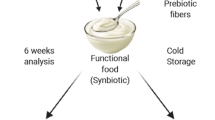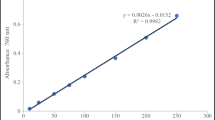Abstract
Survival of two Lactobacillus kefir strains after spray drying in reconstituted skim milk with or without the addition of 12.5 g monosodium glutamate/l, 20 g sucrose/l, or 20 g fructo-oligosaccharides (FOS)/l and during subsequent storage under different conditions of temperature (20 and 30°C) and relative humidity (RH) (0, 11 and 23%) was evaluated. After being dried, L. kefir 8321 and L. kefir 8348 had a decrease in viability of 0.29 and 0.70 log cfu/ml respectively, while the addition of different protectants improved the survival of both strains significantly. During storage, bacterial survival was significantly higher under lower conditions of RH (0–11%), and monosodium glutamate and FOS proved to be the best protectants.



Similar content being viewed by others
References
Ananta E, Birkeland SE, Corcoran B, Fitzgerald G, Hinz S, Klijn A, Mättö J, Mercernier A (2004) Processing effects on the nutritional advancement of probiotics and prebiotics. Microb Ecol Health Dis 16:113–124
Ananta E, Volkert M, Knorr D (2005) Cellular injuries and storage stability of spray-dried Lactobacillus rhamnosus GG. Int Dairy J 15:399–409
Carvalho AS, Silva J, Ho P, Teixeira P, Gibbs P, Malcata FX (2003) Protective effect of sorbitol and monosodium glutamate during storage of freeze-dried lactic acid bacteria. Lait 83:203–210
Castro HP, Teixeira PM, Kirby R (1995) Storage of lyophilized cultures of Lactobacillus bulgaricus under different relative humidities and atmospheres. Appl Microbiol Biotechnol 44:172–176
Chávez BE, Ledeboer AM (2007) Drying of probiotics: optimization of formulation and process to enhance storage survival. Dry Technol 25:1193–1201
Corcoran BM, Ross RP, Fitzgerald G, Stanton C (2004) Comparative survival of probiotic lactobacilli spray dried in the presence of prebiotic substances. J Appl Microbiol 96:1024–1039
Desmond C, Stanton C, Gitzgerald GF, Collins K, Ross RP (2001) Environmental adaptation of probiotic lactobacilli towards improvement of performance during spray-drying. Int Dairy J 11:801–808
Desmond C, Ross RP, O’Callaghan E, Fitzgerald G, Stanton C (2002) Improved survival of Lactobacillus paracasei NFBC 338 in spray dried powders containing gum acacia. J Appl Microbiol 93:1003–1011
Ferreira V, Soares V, Santos C, Silva J, Gibbs PA, Teixeira P (2005) Survival of Lactobacillus sakei during heating, drying and storage in the dried state when growth has occurred in the presence of sucrose or monosodium glutamate. Biotechnol Lett 27:249–252
Fooks LJ, Gibson GR (2002) Probiotics as modulators of the gut flora. Br J Nutr 88:39–49
Golowczyc M, Silva J, Abraham A, De Antoni G, Teixeira P (2010) Preservation of probiotic strains isolated from kefir by spray-drying. Lett Appl Microbiol 50:7–12
Morgan CA, Herman N, White PA, Vesey G (2006) Preservation of micro-organisms by drying: a review. J Microbiol Met 66:183–193
Santivarangkna C, Kulozik U, Foerst P (2008) Inactivation mechanisms of lactic acid starter cultures preserved by drying processes. J Appl Microbiol 105:1
Schwab C, Vogel R, Ganzle MG (2007) Influence of oligosaccharides on the viability and membrane properties of Lactobacillus reuteri TMW1.106 during freeze-drying. Cryobiology 55:108–114
Sunny-Roberts EO, Knorr D (2009) The protective effect of monosodium glutamate on survival of Lactobacillus rhamnosus GG and Lactobacillus rhamnosus E-97800 (E800) strains during spray-drying and storage in trehalose-containing powders. Int Dairy J 19:209–214
Teixeira P, Castro MH, Malcata FX, Kirby RM (1995) Survival of Lactobacillus delbrueckii ssp. bulgaricus following spray-drying. J Dairy Sci 78:1025–1031
Acknowledgments
This work was supported by the Agencia Nacional de Investigaciones Científicas y Tecnológicas, CONICET, Facultad de Ciencias Exactas, UNLP, and Programa Iberoamericano de Ciencia y Tecnología para el Desarrollo (Cyted) Red Temática P107RT0207.
Author information
Authors and Affiliations
Corresponding author
Rights and permissions
About this article
Cite this article
Golowczyc, M.A., Gerez, C.L., Silva, J. et al. Survival of spray-dried Lactobacillus kefir is affected by different protectants and storage conditions. Biotechnol Lett 33, 681–686 (2011). https://doi.org/10.1007/s10529-010-0491-6
Received:
Accepted:
Published:
Issue Date:
DOI: https://doi.org/10.1007/s10529-010-0491-6




